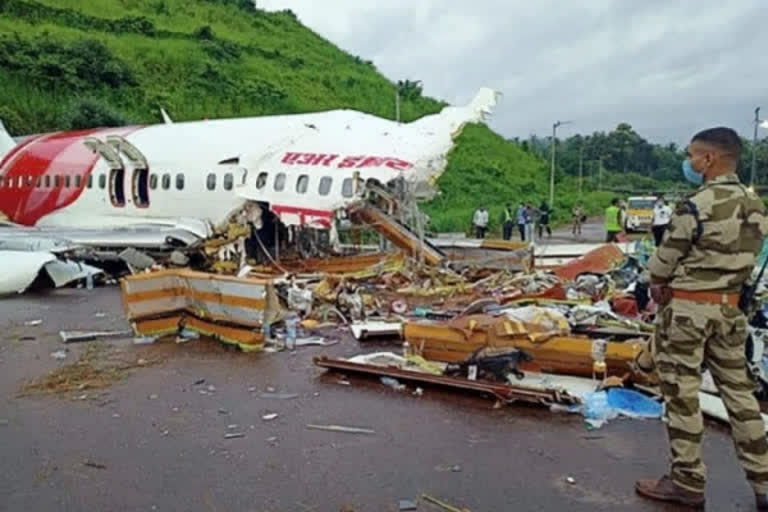New Delhi: The investigation into the plane crash at the Kozhikode airport in August last year, in which 21 people died, has revealed that PF (pilot flying) had not adhered to the standard operating procedure and ignored a warning call by the PM (pilot monitoring) and landed beyond the touchdown zone.
The Aircraft Accident Investigation Bureau (AAIB) in its 257-page investigation report released on Saturday stated, "The probable cause of the accident was the non-adherence to SOP by the PF, wherein, he continued an unstabilized approach and landed beyond the touchdown zone, halfway down the runway, in spite of 'Go Around’ call by PM which warranted a mandatory 'Go Around' and the failure of the PM to take over controls and execute a 'Go Around'."
Last year on August 7, an Air India Express Boeing 737-800 aircraft, operating a Kozhikode-Dubai flight with 184 passengers, including ten infants and six crew members on board, crashed on landing at 7.41 pm.
The investigation report was submitted by the five-member committee headed by Capt. SS Chahar, a former designated examiner on Boeing 737NG. Other members of the committee were Ved Prakash (operations expert), Mukul Bhardwaj (senior aircraft maintenance engineer for Boeing 737), Y.S. Dahiya (aviation medicine expert) and Jasbir Singh Larhga (deputy director of AAIB).
READ: Kozhikode plane crash survivor recounts harrowing experience
"The investigation team is of the opinion that the role of systemic failures as a contributory factor cannot be overlooked in this accident. A large number of similar accidents/incidents that have continued to take place, more so in AIXL (Air India Express), reinforce existing systemic failures within the aviation sector. These usually occur due to prevailing safety culture that gives rise to errors, mistakes and violation of routine tasks performed by people operating within the system," stated the AAIB report.
The report said that there was only 01 Captain against 26 First Officers on the posted strength at Kozhikode. "The actions and decisions of the PIC were steered by a misplaced motivation to land back at Kozhikode to operate next day morning flight AXB 1373. The unavailability of a sufficient number of Captains at Kozhikode was the result of faulty AIXL HR policy which does not take into account operational requirement while assigning permanent base to its Captains," it added.
The Pilot In Command (PIC) had vast experience of landing at Kozhikode under similar weather conditions. This experience might have led to overconfidence leading to complacency and a state of reduced conscious attention that would have seriously affected his actions, decision making as well as CRM, said the report.
According to the report, the existing runway strip at Kozhikode airport extends laterally to a distance of only 75m from the runway centreline on either side. The presence of steep slopes on all sides of the runway and the non-availability of additional land with AAI makes it impracticable to expand the runway strip width from 75m to 140m. The existing runway strip meets all other requirements of DGCA CAR / ICAO Annex 14 except for the width of the runway strip.
READ: Kozhikode crash: AI Express offers final compensation to all injured flyers, next of kin of deceased
In its recommendations, the AAIB report noted that in view of the failure of the AIXL pilot training program to impart the requisite skills for performance enhancement due to lack of its effectiveness, it is recommended that: (a) In order to impart training in realistic situations, flight simulators to be used extensively. Emphasis is to be laid on the following scenarios during the flight simulator briefing/training, the Chief of Training to ensure that the assessment reports (CA 40/CA41) done by the DEs are complete in all aspects. All ‘training forms’ are to be scrutinized critically by the AIXL Training Department as well as by DGCA during their inspections.
In order to ensure compliance with SOPs and CRM principles, AAIB recommended that AIXL enhance their observation flight by senior pilots, trainers and carry out additional observation flights during monsoon as recommended by DGCA. Inspection of flight recorder system, CVR monitoring to effectively analyse and address the established weaknesses in non-technical skills including Cockpit Gradient, were also among few other recommendations of the AAIB.



